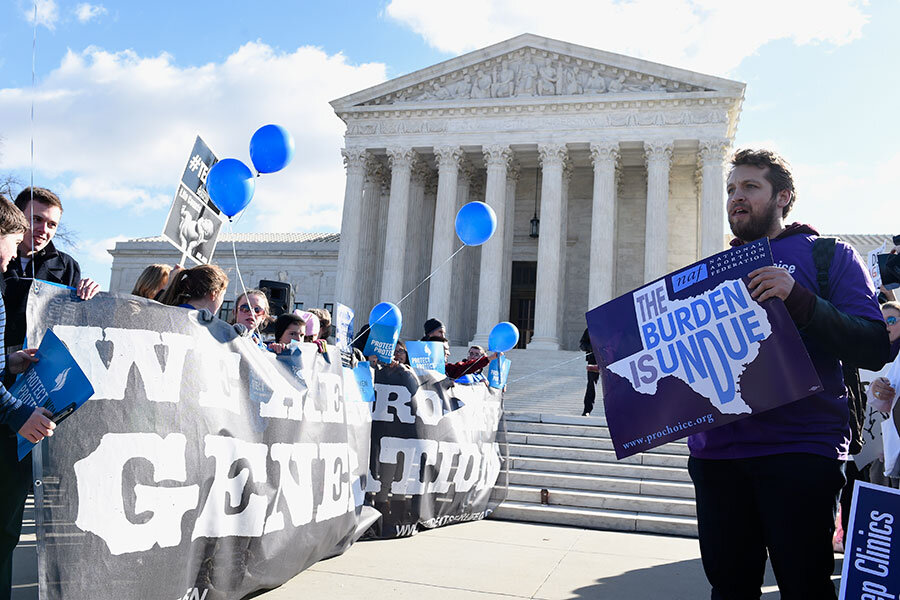Supreme Court hearing sets up landmark abortion decision
Loading...
In advance of Wednesday's Supreme Court case, the Monitor examined abortion in Texas in a three-part series looking at those most affected by the Texas law, the pro-life answer to abortion clinics, and how hard it is to get an abortion.
The divisive issue of abortion returns to the United States Supreme Court on Wednesday in a case from Texas that could dramatically shift the legal landscape for women’s reproductive rights nationwide.
The case features high drama both inside the court as the justices hear oral argument, as well as on the sidewalk outside.
Abortion-rights activists and antiabortion advocates are holding large competing rallies with speaker lists featuring top leaders in both camps and supportive members of Congress.
At issue in Whole Woman’s Health v. Hellerstedt is whether a Texas law – House Bill 2 – is an acceptable regulation of abortion providers in accord with the high court’s prior abortion rulings.
The case will examine whether the measure is creating substantial obstacles for Texas women in a way that places an undue burden on a woman’s constitutional right to end her pregnancy before fetal viability.
The case is a potential landmark because conservative lawmakers in a growing number of states have adopted similar laws that are restrictive of abortion rights.
With the sudden passing of Justice Antonin Scalia on Feb. 13, the Supreme Court case will be heard and decided by an eight-member court.
Legal analysts say the deciding vote will likely be cast by Justice Anthony Kennedy. If he sides with the court’s conservatives it would form a 4-to-4 tie which would mean that an earlier appeals court ruling in the Texas case would stand.
That would uphold HB2 in most applications and mark a substantial defeat for abortion-rights groups. A 4-to-4 tie would also mean the decision would apply only in Texas, Louisiana, and Mississippi.
If, on the other hand, Justice Kennedy sides with the court’s liberals, that would form a 5-to-3 majority that could strike down the law in its entirety or moderate its enforcement. In addition, it would set a nationwide precedent.
The challenged provisions require abortion doctors in Texas to obtain admitting privileges at a local hospital. They also require that clinics comply with the higher standards of an ambulatory surgical center (ASC).
Amy Hagstrom Miller, owner of Whole Woman’s Health, the lead petitioner in the Supreme Court case, says the new regulations are designed to close down clinics.
“At the beginning of all this, Whole Woman’s Health had 14 physicians who worked in our clinics and we worked with 25 hospitals in five different cities,” she says. But after the new admitting privileges requirement, only three of the physicians were able to obtain the required approval.
“So the admitting privileges challenge along with the ambulatory surgical center restriction is a perfect storm – and our opposition knows it,” she says. “It was by design.”
Texas lawmakers say the provisions help make abortions safer for Texas women. State officials reject claims that HB2 is merely a pretext to shut down clinics.
“Petitioners have nothing close to the clearest proof needed to show that the legislature’s stated purpose is a sham,” Texas Solicitor General Scott Keller said in his brief to the court.
Following enforcement of HB2, the number of clinics in the state fell from more than 40 to 19 currently. If the high court upholds the law, the number of clinics in Texas would drop to 10.
Admitting privilege requirements, like those in Texas, have been enacted in nine other states (Alabama, Kansas, Louisiana, Missouri, Mississippi, North Dakota, Oklahoma, Tennessee, and Wisconsin).
ASC standards have been enacted in six states (Michigan, Missouri, Pennsylvania, Tennessee, Texas, and Virginia).
Several other states are considering passing similar laws.
During the court’s scheduled 90 minutes of oral argument, all eyes will be on Justice Kennedy. His body language, his questions, any statements he makes from the bench will be parsed and analyzed for hints of how he may rule.
At the heart of the case is the Supreme Court’s landmark 1992 ruling in Planned Parenthood of Southeastern Pennsylvania v. Casey.
In that case, the Supreme Court said that state governments were free to pass certain abortion regulations but that those regulations could not impose a substantial obstacle to a woman seeking an abortion.
The Supreme Court must decide where to draw that line and on which side of the line Texas HB 2 falls.
A high court decision that clarifies that standard could put an end to much of the conservative legislative activity that is restricting access to abortions in states with conservative legislatures. On the other hand, it could open the way for even more restrictive laws.
A decision in the case is expected by late June.
Please see the Monitor's three-part series:
Part 1: In Texas, a side of abortion debate few ever see
Part 2: Inside the 'pro-life' answer to abortion clinics
Part 3: How difficult is it to get an abortion in Texas?





